Saturday, June 20, 2009
Some very interesting activities have been going happening on board the Knorr the last couple of days. While everyday there is a routine of cruising to a station, stopping and dropping plankton nets and/or other probes, other, more exotic experiments get deployed. For example, yesterday researcher Pat Kelley from the University of Rhode Island and his team retrieved sediment traps that they had set out 24 hours before. Their interest is seeing what is settling to the bottom of the ocean and at what rate this material is settling. To do this, they use a rather ingenious device. They take tubes and fill them with salt water that is many times more concentrated then regular seawater. Because it is so dense, the concentrated saltwater stays in the open toped tube as it is lowered into the ocean. Anything that falls into this liquid stays in the trap and can be recovered for analysis. That’s where it gets interesting. Deploying and then recapturing a drifting probe can be a little tricky. After letting the sediment trap loose for 24 hours, you first have to go back and find it. Fortunately the trap uses a satellite beacon that broadcasts its position to the ARGOS satellite system. The Argos program is administered under a joint agreement between the National Oceanic and Atmospheric Administration (NOAA) and the French space agency, Centre National d’Etudes Spatiales (CNES). The system consists of in-situ data collection platforms equipped with sensors and transmitters and the Argos instrument aboard the NOAA Polar-orbiting Operational Environmental Satellites (POES). The Argos system will lead you right to your instrument, then you have t get it on board.
After they locate the instrument, they bring the ship along side and "lasso” so the deck crew can attach a cable and lift it out of the water using the A-frame crane located on the aft portion of the ship.
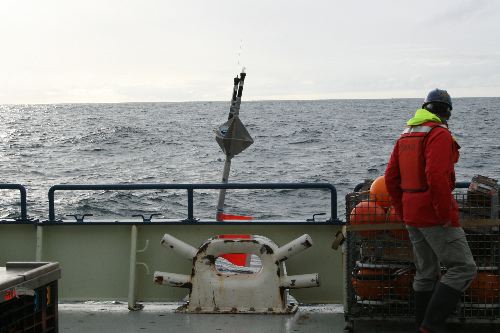 Buoy along side
Buoy along side
Sediment Trap Buoy along side the Knorr
The sediment traps are attached to a long line comprised of a heavy weight at one end with floats and a buoy at the other. The device is separated and brought up in sections so that they can be brought aboard using one of the ships cranes.
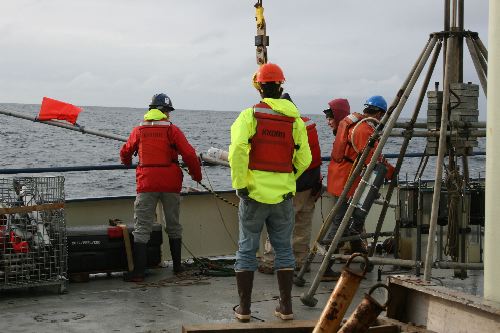 Capture the Flag
Capture the Flag
Lefting Buoy onto Knorr deck
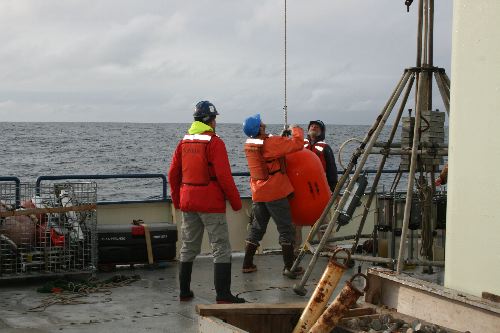 Disconecting float
Disconecting float
Removing float section of Sediment Trap
This takes a lot of skill to do, especially when on a deck that is slippery and rocking with the waves. Remember that this is done in between the other experiments and device tows. The deck crew is probably the busiest and hardest working group on this cruise.
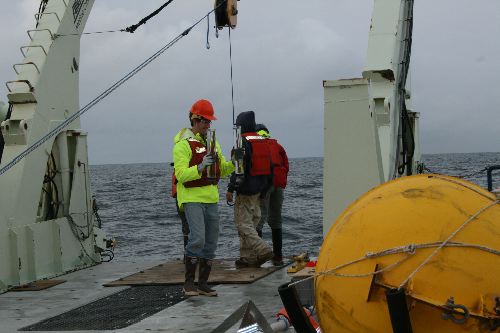 Sediment Trap vials
Sediment Trap vials
Collecting Sediment Trap Tubes
Another group on the cruise is the U.S. Fish and Wildlife Service "bird people” as they seem to be know as on the ship. They are made up of Elizabeth Labunski and Sophie Webb, both of which position themselves on the ships bridge so that they can survey what birds and marine mammals are present in-between stations. The Eastern Bering Sea is a very productive area and is rich in bird life. I went up to visit them on the bridge.
 Bird Survey
Bird Survey
Elizabeth Labunsk and Third Mate Alison Paz surveying Bering Sea birdlife
While there they identified a rather unhappy Red-legged Kittiwake (Rissa brevirostris) sitting rather pitifully near the bow of the ship. These birds are interesting because as opposed to their Black-legged cousins, they have a very narrow distribution.
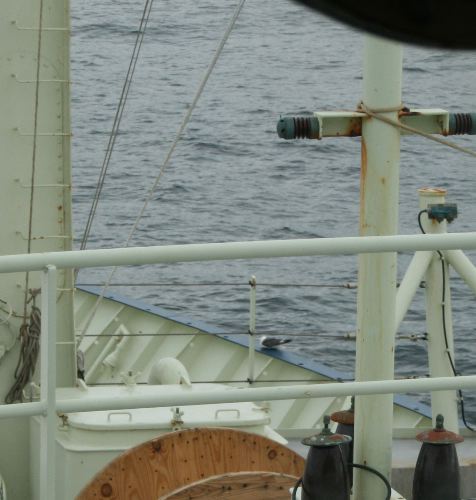 Unhappy Red-legged Kittiwake
Unhappy Red-legged Kittiwake
Weak Red-footed Kittiwake
According to the Audubon Society, Red-legged Kittiwake's breeding distribution is limited to just four localities in the Bering Sea: Alaska's Pribilof Islands, Bogoslof Islands, and Buldir Island, and Russia's Commander Islands. More than 75% of the species' known population breeds on St. George Island in the Pribilofs, which were about 40 miles from where we were cruising. The weakened bird was captured so that it could be warmed up and released when it regained its strength.
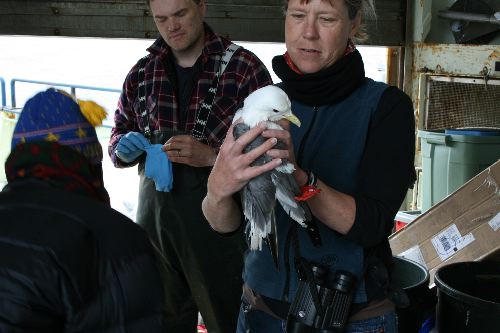 Red-legged Kitiwake
Red-legged Kitiwake
Sophia Webb holding Red-legged Kittiwake (Dr. David Shull in background, Heather Whitney preparing a temporary box for the bird)

